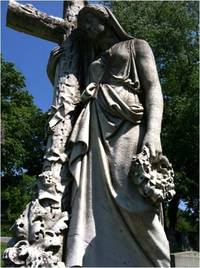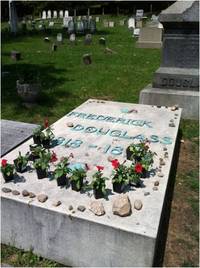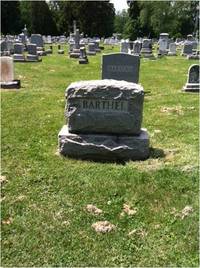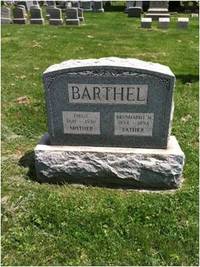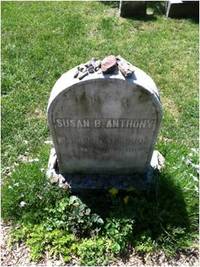by Michelle Ann Kratts
We had our lunch under a blazing canopy of oak trees. It was hot in Rochester, but they spread their wings above us and we were suddenly part of the circle they made around the murky green and ancient kettle lake. Peter and I were meeting with Marilyn Nolte, a member of the Friends of Mt. Hope Cemetery, tour guide and historian, at noon, and there were a few minutes to waste. So when we were finished we wandered around the ranks of monuments that filled the grounds. Unbelievably, our happy steps led us down a path that led directly to the grave of Frederick Douglass.
Thundering before us, there he stood. His grave is not very modest. In fact he has two monuments; one upright and one lying down (placed there after Douglass’s children found a more accurate year for his birth—being born into slavery, Douglass, himself, was never quite sure of the date). There were many stones and little planters left behind and young flowers reaching toward heaven on top of his memorial. We stood in awe before this great American and probably both of us couldn’t help but wonder if Frederick Douglass, himself, had stood before the modest grave we had come to Rochester to see—the grave of Niagara’s own soldier for human rights, John Morrison.
John Morrison’s name, though not well known, should be mentioned alongside men like Frederick Douglass. He was one of the unsung heroes who vanished with time. There were probably many other African American men and women who did the kinds of things that John Morrison did—and they, too have been forgotten. In Niagara Falls, careful research turned the name of John Morrison up over and over again. Finally it became quite apparent that he was someone special. For the longest time we knew of his deeds, but we did not know what had become of the man. It wasn’t until a few months ago that Peter Ames tracked him down in Rochester. He found this brave warrior’s last stop…an unmarked grave at Rochester’s, Mt. Hope Cemetery. And we planned a trip as soon as was possible.
There was some new information that popped up, too. Information that continued to lead us to the probability that both John and his wife, Flora, were indeed active in the Underground Railroad movement. Flora A. Morrison died in 1900 and left an estate worth a whopping $20,000. It is hard to believe that an African American woman, who had worked in Rochester as a nurse, could have amassed such an incredible sum of money at the turn of the century. This is yet another mystery to be solved. Interestingly enough the executor of Flora’s will was Henry Quinby—a relation of Rev. Henry Quinby, a Hicksite Quaker who was also a founder of the Rochester Anti-Slavery Society. The Quinby’s were also personally attached to Frederick Douglass.
We finally met up with Marilyn, who was a beacon of historical knowledge concerning the residents of Mt. Hope Cemetery, and she proceeded to take us on a private tour of the grounds. Mount Hope is a gigantic cemetery, one of the original cemeteries created during the period of the Rural Cemetery Movement. There are up to 375,000 residents lying beneath the beautiful romantic and hilly grounds. There are angels reaching toward heaven, giant obelisks, over eighty private mausoleums. There are gardens, fountains and gazebos. Gorgeous Victorian chapels and a bell tower. Unfortunately, Marilyn had forgotten her key, or we may have been able to go into the bell tower. How wonderful it would have been to ring the bell!
Finally we came to Morrison’s grave. It was quite a walk on a hot spring day. Marilyn led us to the open site that held three graves: John W. Morrison, Flora A. Morrison and Flora’s brother, John Peiper.
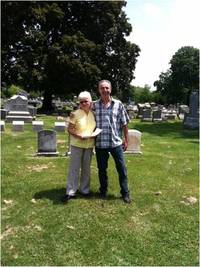 Marilyn and Peter on the site of the Morrison burials
Marilyn and Peter on the site of the Morrison burials
Excited to finally be at the final resting spot, Peter went ahead, while Marilyn and I lingered over another grave. But I could see from Peter’s expression that something incredible was just ahead of me. He only smiled and said that I would not believe what I would see when I made it to the site. So I walked toward him and there it was.
Beside him was another grave, one that, for over one hundred years, has looked down upon the Morrison site. I was struck as if by lightening when I saw the words that were etched upon the stone: BARTHEL.
That was all the front of the stone read but a part of me shivered. Barthel is my maiden name, my father’s name passed down to me. As far as I know, this is the only site in the cemetery with that name and it stands before the grave we had come many miles to see. I looked at the backside and there were two names clearly etched: Emilie and Bernhardt Barthel.
Even more stunned, I stood there and wondered what the chances could be that my great great grandmother’s exact name would be etched upon this grave. This was not the site of my ancestors’ graves (they are buried in Wheeling, West Virginia) but my great great grandmother (who died at a tragically young age) was also named Emilie Barthel and her husband named a similar, Reinhardt. They had emigrated from Switzerland during the early 1880’s. According to their passenger list, their first stop was somewhere in New York. Perhaps it was Rochester? Perhaps they came here before they went their merry way? Perhaps they visited or lived with these relatives? My Barthel ancestors, Emilie and Reinhardt, were of the same generation as these Barthels. Later on, I researched these people and found that they were two of only a handful of Barthels in Rochester during this time period. Bernhardt was a fresco painter. Perhaps, one day I will have enough evidence to prove a family relation. But for now, it is just a name that I call my own—a name, inextricably attached to the man that I have marveled at for so many years.
Our day was not over. There was still so much to see and one last little stop I needed to make. Mt. Hope also contains the grave of yet another American hero, actually, heroine—Susan B. Anthony. Her grave is located in one of the most beautiful sections of the cemetery. We found her in a little row of whitewashed stones. Very austere, Marilyn announced…for the Anthony’s were Quakers. I stood so close beside her and touched the simple stone—imagining the wonderful woman who made so many of us free. She stood for equality and human rights for each and every American.
Visitors had planted flowers to honor this simple spot and laid little stones on top of the grave—that typical calling card. I did nothing but marveled at the woman who slept below me. I wanted to stay there the rest of the day. I wanted to sit down and to tell her a few things. And I wanted to listen to what she would have to say to me.
